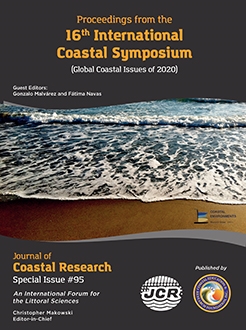Lee, T.; Moon, J.-H.; Jung, S.-K.; Park, G.; Kwon, S.; Min, S.-H., and Son, Y.B., 2020. Changes of nutrient budget due to physiochemical factors in the coastal area of Jeju, Korea. In: Malvárez, G. and Navas, F. (eds.), Global Coastal Issues of 2020. Journal of Coastal Research, Special Issue No. 95, pp. 57–61. Coconut Creek (Florida), ISSN 0749-0208.
In Jeju coastal area which is UNESCO biosphere reserve, there has recently been eutrophication and serious changes in the coastal ecosystem such as coastal fishery decline and green algal bloom. A large amount of nutrients that inflow to the coastal area through the discharge of land-based aquaculture farms (LAFs) and submarine groundwater discharge (SGD) are transported by the tidal current. We established representative area of the Jeju coastal area and calculated the nutrients budget of the LAFs, SGD, primary production (PP), and sediment in this study area. The advection-diffusion equation applied to the model was calculated through the passive tracer experiments. The water mass transport in and out of the study area was estimated by modeling, and the nutrient fluxes was calculated by water volume and nutrient concentration. The nutrient released from the aquaculture farms are primarily determined by the reversing tidal currents along the coast of the study area, showing a narrow band of coast, indicating little cross-isobath nutrient exchange between the nearshore and offshore water. The amount of total carbon (TC), dissolved inorganic nitrogen (DIN), dissolved inorganic phosphorus (DIP) and dissolved silicon (DSi) influxes into the study area from the LAFs, SGD and offshore were 2,696,282 kg·day-1, 18,823 kg·day-1, 3,395 kg·day-1 and 65,723 kg·day-1, respectively. The amount of TC, TN, TP and Si outfluxes transported from the study area to the offshore, deposited in the sediment and used for PP were 2,696,274 kg·day-1, 18,821 kg·day-1, 3,394 kg·day-1 and 65,721 kg·day-1, respectively. In the study area nutrients are accumulating due to inflows more than outflows. The accumulation rate of TC, DIN, DIP and DSi are 2.29 mg·m-3·day-1, 0.76 mg·m-3·day-1, 0.18 mg·m-3·day-1, 1.06 mg·m-3·day-1, respectively. The coastal area of Jeju is accumulating nutrients, which could increase coastal pollution such as eutrophication, green algal bloom and whitening.





